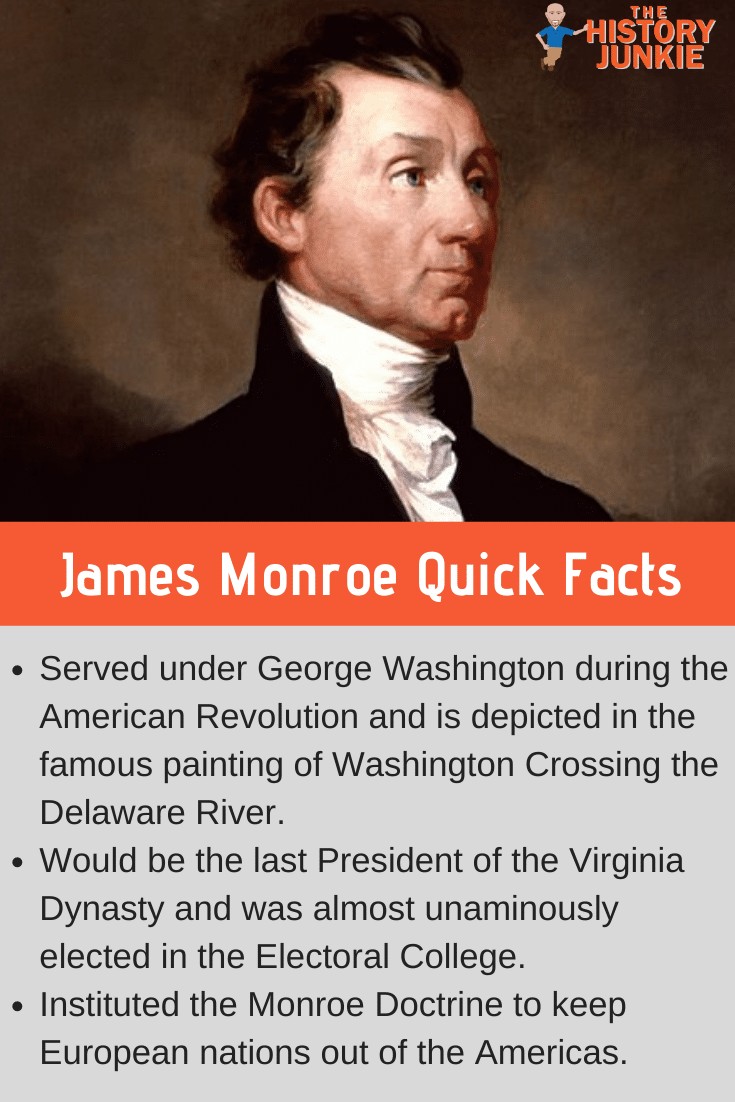President James Monroe would be the last of the “Virginia Dynasty” and had paid his dues to get to the position.

He served under George Washington in the Revolutionary War and under James Madison during the Constitutional Convention. He played a vital role in both Jefferson's and Madison’s administrations.
He cruised to an easy election and helped usher in the “Era of Good Feeling.”
Jump to:
First Term
March 4, 1817: President James Monroe delivers his Inaugural Address. He proposes the establishment of an adequate federal military, funding for national improvements such as interstate roads, and a stable national banking system. With the Federalist Party all but dead
April 28-29, 1817: The signing of the Rush-Bagot Agreement occurred. This would disarm the American and British forces on the Great Lakes.
July 12, 1817: After President Monroe visited Boston, a Bostonian newspaper named Columbian Centinal labels the time the “Era of Good Feelings.”
December 26, 2017: In response to Seminole raids across the border of Florida, General Andrew Jackson begins to raid Florida and pursue hostile Seminoles. Andrew Jackson sends President Monroe a letter stating that he planned to invade Florida and take possession. Monroe does not respond.
April 7-May 24, 1818: Andrew Jackson invades Florida and takes control of St. Mark’s and Pensacola. This occurs when John Quincy Adams was negotiating with Spain for the purchase of Florida. Jackson also executes two British traders, which ignites a popular outrage in England, but England does nothing. Monroe also does nothing due to how popular Jackson has become for his exploits.
October 20, 1818: The border was set between the United States and Canada at the 49th parallel, with the exception of the Oregon Territory. This took place at the Convention of 1818.
November 18, 1818: John Quincy Adams makes an aggressive move on Spain during negotiations over the purchase of Florida. He tells Spain that Jackson’s invasions were necessary due to self-defense and that if Spain was unable to control the region, it should cede Florida to the United States.
February 2, 1819: Chief Justice John Marshall rules in favor of Dartmouth College in the case of Trustees of Dartmouth College vs. Woodward, which emphasizes the term “contract” as a transaction between private parties.
February 22, 1819: Florida is given to America with the Adams-Onis Treaty, which also renounces America’s claim to Texas. The treaty would be ratified by the U.S. Senate two years later. John Quincy Adams successfully navigated a tricky situation with much shrewdness.
March 6, 1819: In McCullough v. Maryland, the Supreme Court ruled that Congress has the power to incorporate a national bank. Chief Justice Marshall used Alexander Hamilton’s doctrine implied powers to rule that the bank’s creation was constitutional. Declaring “the power to tax involves the power to destroy.” Marshall also denies Maryland the right to tax the Baltimore branch of the bank.
January 20, 1820: President James Monroe advocates for an independent colony established in Africa. The colony was purchased and called Liberia. The United States had planned to send African Americans to the colony. Congress appropriates $100,000 to its founding.
March 6, 1820: James Monroe signs the Missouri Compromise, which divides America into free and slave states. This compromise would add to the foundation of the Civil War.
April 20, 1820: The Land Act is passed by Congress. This credit system is abolished, which requires cash payments for all public land purchases. This occurred because of the Panic of 1819.
May 15, 1820: Congress agrees to pay $50 to anyone informing them of illegal slave trading.
December 6, 1820: James Monroe wins re-election
Second Term
March 5, 1821: James Monroe delivers his inauguration on a Monday, which was the first in history.
September 4, 1821: Czar Alexander I created friction between the United States and Russia when he redefined the 49th parallel in the Oregon Territory.
March 8, 1821: Latin-American governments are recognized by America
March 22, 1822: General Andrew Jackson was nominated to run for President in 1824.
June 19, 1822: The United States recognizes Colombia as an independent country.
October 20, 1822: Congress of Verona meets, but only causes more friction in Europe.
November 18. 1822: Henry Clay was nominated to run for President in 1824.
December 12, 1822: The United States recognizes Mexico as an independent country
January 27, 1823: The States recognize Argentina as an independent country
July 17, 1823: John Quincy Adams protests Russian claims on Oregon territory. His arguments would lay the foundation of the Monroe Doctrine.
August 20, 1823: Britain proposes a joint Anglo-U.S. Alliance against European intervention. Secretary of State John Quincy Adams advises that America take the lead. Britain follows and agrees to recognize new Latin American republics.
October 9, 1823: France agrees to disavow any claims on former Spanish colonies in the Americas.
December 2, 1823: President James Monroe follows Adam's advice and adopts the Monroe Doctrine, which forbids any European nation from colonizing the Americas, and it would be considered a direct threat.
February 15, 1824: John Quincy Adams nominated for President
March 30, 1824: Henry Clay promote the Tariff of 1924, which would lower dependence on foreign goods.
April 14, 1824: Russia agrees to withdraw claims to a potion of Oregon Territory. The United States agrees to these terms.
April 30, 1824: Congress passes a bill authorizing the president to order surveys for internal improvements, such as the building of roads and canals.
December 1, 1824: John Quincy Adams was elected president despite a controversial election that should have gone to Andrew Jackson. Adams won due to his influence in Congress.
